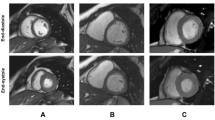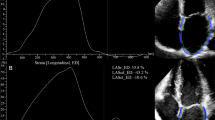Abstract
Cardiac complications are the major cause of mortality in patients with Thalassemia major (TM). Cardiac T2* MRI is currently the gold standard for assessing myocardial iron concentration. The aim of our study was to assess whether any echocardiographic parameter would correlate with these findings in patients well established on chelation therapy. This was a prospective study on patients with TM who are regularly followed in our clinic. Patients had a cardiac MRI and echocardiogram within 2 months of each other. Echo parameters included global longitudinal strain and diastolic function. We also compared these findings with those from a cohort of thalassemia intermedia (TI) and normal controls. A total of 84 patients (mean age 26.3 ± 6.1 years, 42.8% male) with TM were enrolled. All had normal left ventricular ejection fraction and only 8 patients had MRI T2* < 10. As compared to 17 patients with TI and 53 controls, these patients had significantly higher E/E’ and lower pulmonary vein s/dd ratio suggesting early diastolic dysfunction. 28 patients fulfilled criteria for diastolic dysfunction even in the presence of normal MRI T2*. Global longitudinal strain (GLS) was significantly lower in the TM group as compared to the TI and controls. We found no correlation between any of the echo findings and the MRI T2*in TM patients. In patients with thalassemia and MRI T2* > 20 ms features of diastolic dysfunction persist even in the presence of normal LV function and normal GLS. This suggests that diastolic function remains abnormal even when myocardial iron concentrations are normal and follow up therefore is essential.

Similar content being viewed by others
References
Hamamy HA, Al-Allawi NA (2013) Epidemiological profile of common haemoglobinopathies in Arab countries. J Community Genet 4(2):147–167
Kim S, Tridane A (2017) Thalassemia in the United Arab Emirates: why it can be prevented but not eradicated. PLoS One 12(1):e0170485
Origa R (2017) Beta-thalassemia. Genet Med 19(6):609–619
Viprakasit V, Ekwattanakit S (2018) Clinical classification, screening and diagnosis for thalassemia. Hematol Oncol Clin North Am 32(2):193–211
Pennell DJ, Udelson JE, Arai AE, Bozkurt B, Cohen AR, Galanello R et al (2013) Cardiovascular function and treatment in beta-thalassemia major: a consensus statement from the American Heart Association. Circulation 128(3):281–308
Marcon A, Motta I, Taher AT, Cappellini MD (2018) Clinical complications and their management. Hematol Oncol Clin North Am 32(2):223–236
Ansari-Moghaddam A, Adineh HA, Zareban I, Mohammadi M, Maghsoodlu M (2018) The survival rate of patients with beta-thalassemia major and intermedia and its trends in recent years in Iran. Epidemiol Health 40:e2018048
Wu HP, Lin CL, Chang YC, Wu KH, Lei RL, Peng CT et al (2017) Survival and complication rates in patients with thalassemia major in Taiwan. Pediatr Blood Cancer 64(1):135–138
Taher AT, Weatherall DJ, Cappellini MD (2018) Thalassaemia. Lancet 391(10116):155–167
Paul A, Thomson VS, Refat M, Al-Rawahi B, Taher A, Nadar SK (2019) Cardiac involvement in beta-thalassaemia: current treatment strategies. Postgrad Med 131(4):261–267
Porter JB, Cappellini MD, Kattamis A, Viprakasit V, Musallam KM, Zhu Z et al (2017) Iron overload across the spectrum of non-transfusion-dependent thalassaemias: role of erythropoiesis, splenectomy and transfusions. Br J Haematol 176(2):288–299
Anderson LJ, Holden S, Davis B, Prescott E, Charrier CC, Bunce NH et al (2001) Cardiovascular T2-star (T2*) magnetic resonance for the early diagnosis of myocardial iron overload. Eur Heart J 22(23):2171–2179
Christoforidis A, Haritandi A, Perifanis V, Tsatra I, Athanassiou-Metaxa M, Dimitriadis AS (2007) MRI for the determination of pituitary iron overload in children and young adults with beta-thalassaemia major. Eur J Radiol 62(1):138–142
Meloni A, De MD, Pistoia L, Grassedonio E, Peritore G, Preziosi P et al (2019) Multicenter validation of the magnetic resonance T2* technique for quantification of pancreatic iron. Eur Radiol 29(5):2246–2252
Dewey M, Schink T, Dewey CF (2007) Claustrophobia during magnetic resonance imaging: cohort study in over 55,000 patients. J Magn Reson Imaging 26(5):1322–1327
McIsaac HK, Thordarson DS, Shafran R, Rachman S, Poole G (1998) Claustrophobia and the magnetic resonance imaging procedure. J Behav Med 21(3):255–268
Leung DY, Ng AC (2010) Emerging clinical role of strain imaging in echocardiography. Heart Lung Circ 19(3):161–174
Poterucha JT, Kutty S, Lindquist RK, Li L, Eidem BW (2012) Changes in left ventricular longitudinal strain with anthracycline chemotherapy in adolescents precede subsequent decreased left ventricular ejection fraction. J Am Soc Echocardiogr 25(7):733–740
Abtahi F, Abdi A, Jamshidi S, Karimi M, Babaei-Beigi MA, Attar A (2019) Global longitudinal strain as an Indicator of cardiac Iron overload in thalassemia patients. Cardiovasc Ultrasound 17(1):24
Poorzand H, Manzari TS, Vakilian F, Layegh P, Badiee Z, Norouzi F (2017) Longitudinal strain in beta.thalassemia major and its relation to the extent of myocardial iron overload in cardiovascular magnetic resonance imaging. Arch Cardiovasc Imag 5:1–5
Mancuso L, Vitrano A, Mancuso A, Sacco M, Ledda A, Maggio A (2018) Left ventricular diastolic dysfunction in beta-thalassemia major with heart failure. Hemoglobin 42(1):68–71
Westwood M, Anderson LJ, Firmin DN, Gatehouse PD, Charrier CC, Wonke B et al (2003) A single breath-hold multiecho T2* cardiovascular magnetic resonance technique for diagnosis of myocardial iron overload. J Magn Reson Imaging 18(1):33–39
Carpenter JP, He T, Kirk P, Roughton M, Anderson LJ, de Noronha SV et al (2011) On T2* magnetic resonance and cardiac iron. Circulation 123(14):1519–1528
Wood JC, Enriquez C, Ghugre N, Tyzka JM, Carson S, Nelson MD et al (2005) MRI R2 and R2* mapping accurately estimates hepatic iron concentration in transfusion-dependent thalassemia and sickle cell disease patients. Blood 106(4):1460–1465
Kirk P, Roughton M, Porter JB, Walker JM, Tanner MA, Patel J et al (2009) Cardiac T2* magnetic resonance for prediction of cardiac complications in thalassemia major. Circulation 120(20):1961–1968
Mitchell C, Rahko PS, Blauwet LA, Canaday B, Finstuen JA, Foster MC et al (2019) Guidelines for performing a comprehensive transthoracic echocardiographic examination in adults: recommendations from the American Society of Echocardiography. J Am Soc Echocardiogr 32(1):1–64
Nagueh SF, Smiseth OA, Appleton CP, Byrd BF III, Dokainish H, Edvardsen T et al (2016) Recommendations for the evaluation of left ventricular diastolic function by echocardiography: an update from the American Society of Echocardiography and the European Association of Cardiovascular Imaging. J Am Soc Echocardiogr 29(4):277–314
Smiseth OA, Torp H, Opdahl A, Haugaa KH, Urheim S (2016) Myocardial strain imaging: how useful is it in clinical decision making? Eur Heart J 37(15):1196–1207
Parsaee M, Akiash N, Azarkeivan A, Alizadeh SZ, Amin A, Pazoki M et al (2018) The correlation between cardiac magnetic resonance T2* and left ventricular global longitudinal strain in people with beta-thalassemia. Echocardiography 35(4):438–444
Hamdy AM (2007) Use of strain and tissue velocity imaging for early detection of regional myocardial dysfunction in patients with beta thalassemia. Eur J Echocardiogr 8(2):102–109
Vogel M, Anderson LJ, Holden S, Deanfield JE, Pennell DJ, Walker JM (2003) Tissue Doppler echocardiography in patients with thalassaemia detects early myocardial dysfunction related to myocardial iron overload. Eur Heart J 24(1):113–119
Chinprateep B, Ratanasit N, Kaolawanich Y, Karaketklang K, Saiviroonporn P, Viprakasit V et al (2019) Prevalence of left ventricular diastolic dysfunction by cardiac magnetic resonance imaging in thalassemia major patients with normal left ventricular systolic function. BMC Cardiovasc Disord 19(1):245
Silvilairat S, Sittiwangkul R, Pongprot Y, Charoenkwan P, Phornphutkul C (2008) Tissue Doppler echocardiography reliably reflects severity of iron overload in pediatric patients with beta thalassemia. Eur J Echocardiogr 9(3):368–372
Kirk P, Sheppard M, Carpenter JP, Anderson L, He T, St PT et al (2017) Post-mortem study of the association between cardiac iron and fibrosis in transfusion dependent anaemia. J Cardiovasc Magn Reson 19(1):36
Kirk P, Carpenter JP, Tanner MA, Pennell DJ (2011) Low prevalence of fibrosis in thalassemia major assessed by late gadolinium enhancement cardiovascular magnetic resonance. J Cardiovasc Magn Reson 13:8
Author information
Authors and Affiliations
Corresponding author
Additional information
Publisher's Note
Springer Nature remains neutral with regard to jurisdictional claims in published maps and institutional affiliations.
Rights and permissions
About this article
Cite this article
Nadar, S.K., Daar, S., Abdelmottaleb, W.A. et al. Abnormal diastolic function and Global longitudinal strain in patients with Thalassemia Major on long term chelation therapy. Int J Cardiovasc Imaging 37, 643–649 (2021). https://doi.org/10.1007/s10554-020-02036-8
Received:
Accepted:
Published:
Issue Date:
DOI: https://doi.org/10.1007/s10554-020-02036-8




